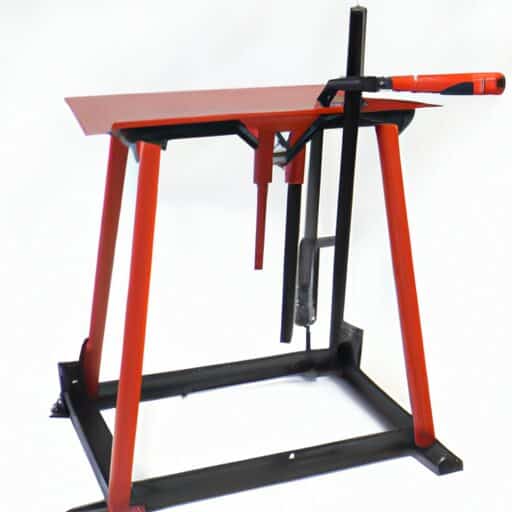Deciding between a portable or stationary welding table can be an overwhelming task, especially for those new to the world of welding. With both options offering unique advantages, it’s essential to weigh the pros and cons before making a decision. In this article, we aim to provide you with a comprehensive overview of the factors to consider when choosing between a portable and stationary welding table, helping you make the right choice that suits your needs and enhances your welding experience. So, buckle up and get ready to explore the world of welding tables!
Benefits of a Portable Welding Table
Easy to Transport
A portable welding table offers the advantage of being easy to transport. It is designed to be lightweight and compact, making it convenient to carry from one job site to another. Whether you are a professional welder who frequently moves between projects or a hobbyist who enjoys welding on the go, a portable welding table allows you to take your work wherever you need to be. Its portability eliminates the hassle of dismantling and reassembling a stationary table, saving you time and effort.
Versatility
Another major benefit of a portable welding table is its versatility. These tables are typically designed with multiple features and adjustable components that allow for a wide range of welding applications. They often come with built-in clamps, slots, and holes that provide flexibility in securing workpieces of various shapes and sizes. Additionally, portable welding tables can be easily converted into different configurations to accommodate different welding techniques or projects. This versatility makes a portable welding table a valuable tool for welders of all skill levels.
Space-saving
If you have limited workshop or storage space, a portable welding table can be a great space-saving solution. These tables are designed to be compact and foldable, allowing you to easily store them when not in use. Unlike stationary welding tables, which can take up a significant amount of space, a portable table can be conveniently tucked away in a corner or hung on a wall, maximizing your workspace efficiency.
Ideal for On-site Jobs
One of the biggest advantages of a portable welding table is its suitability for on-site jobs. Whether you are working on a construction site, repairing equipment in the field, or performing maintenance tasks in remote locations, a portable table provides the convenience and flexibility you need. Its lightweight design and easy setup allow you to quickly get to work without the need for a permanent workbench. Portable welding tables also often come with features like collapsible legs or wheels, making it easy to move around and set up in different locations.
Adjustable Height
A portable welding table typically offers adjustable height settings, allowing you to customize the table’s height to your specific needs. This feature is especially beneficial for welders who prefer to work in a standing or sitting position. Being able to adjust the height of the table ensures comfortable and ergonomic working conditions, reducing the risk of strain or fatigue during long welding sessions. With a portable welding table, you have the freedom to set the height that best suits your workflow and personal preference.
Drawbacks of a Portable Welding Table
Limited Stability
One of the main drawbacks of a portable welding table is its limited stability compared to a stationary table. Due to its lightweight and foldable design, a portable table may not provide the same level of stability and rigidity as a stationary table. This lack of stability can impact the precision and quality of your welds, especially when working with heavier or larger workpieces. It is important to consider the stability requirements of your welding projects before opting for a portable table.
Limited Weight Capacity
Portable welding tables usually have a lower weight capacity compared to stationary tables. While they can handle most light to medium-duty welding tasks, they may not be suitable for heavy-duty projects that involve large workpieces or significant force. Exceeding the weight capacity of a portable table can compromise its structural integrity and pose safety risks. If you frequently work with heavy materials or require a high weight capacity, a stationary welding table may be a more suitable option.
Limited Surface Area
Another limitation of a portable welding table is its smaller surface area compared to a stationary table. The compact size of a portable table may not provide enough space for larger projects or complex assembly setups. This can be particularly challenging when working on projects that require precise positioning and ample room to maneuver various tools and workpieces. If you frequently work on large or intricate projects, a stationary welding table with a larger surface area may better meet your needs.
Less Durable
Portable welding tables are generally designed to be lightweight and portable, which means they may not be as durable as their stationary counterparts. While they are typically constructed from sturdy materials such as steel or aluminum, the emphasis on portability often results in sacrifices in terms of overall durability. The lightweight nature of portable tables can make them more susceptible to wear and tear, especially if subjected to frequent transport or heavy use. Consider your long-term usage expectations and the level of durability required for your welding projects before making a decision.
Less Features
In comparison to stationary welding tables, portable tables often come with fewer features and accessories. They may lack the advanced features commonly found in stationary tables, such as integrated clamping systems, adjustable fence guides, or built-in storage compartments. While portable tables still offer basic functionality and a range of adjustable options, they may not provide the same level of convenience, precision, or customization options. If you rely heavily on specific features for your welding projects, a stationary welding table may be a better choice.
Advantages of a Stationary Welding Table
Superior Stability
One of the key advantages of a stationary welding table is its superior stability. Stationary tables are designed to provide a solid and sturdy work surface, ensuring stability during welding operations. Their fixed structure and heavy-duty construction eliminate any concerns about wobbling or movement, allowing for precise welding even when working with heavy or large workpieces. The stability offered by a stationary table can greatly contribute to the overall quality and accuracy of your welds.
Higher Weight Capacity
Stationary welding tables generally have a higher weight capacity compared to portable tables. They are specifically engineered to handle heavy-duty welding projects involving large, bulky, or extremely heavy workpieces. With their robust construction and weight-bearing capacity, stationary tables can withstand significant force and weight without compromising their integrity. If you regularly work with heavy materials or require a high weight capacity, a stationary welding table is a suitable choice.
Large Surface Area
A major advantage of a stationary welding table is its large surface area. The generous workspace provided by a stationary table allows for more flexibility and efficiency during welding tasks. Whether you need ample room for positioning multiple workpieces or require sufficient space for complex jig setups, a stationary table can accommodate your needs. Additionally, the larger surface area of a stationary table enables better organization of tools, materials, and welding accessories, further enhancing your productivity.
Durability
Stationary welding tables are known for their durability and long-lasting performance. Built to withstand heavy use and challenging environments, these tables are constructed from high-quality materials, such as heavy-gauge steel or cast iron, that can resist corrosion, impacts, and extreme temperatures. Their solid and rigid structure ensures longevity, even when exposed to intense welding processes or constant use. If you prioritize a durable and long-lasting investment, a stationary welding table is a reliable choice.
Advanced Features
Stationary welding tables often come equipped with advanced features and accessories that enhance productivity and convenience. These features may include integrated clamping systems, adjustable fence guides, built-in storage compartments, cutting slots, or even built-in fume extraction systems. The availability of these advanced features allows for improved accuracy, efficiency, and overall ease of use during welding operations. If you require specific features or prefer the convenience of integrated tools, a stationary welding table can provide you with the necessary functionalities.
Disadvantages of a Stationary Welding Table
Not Easily Transportable
One of the main drawbacks of a stationary welding table is its lack of portability. Unlike portable welding tables, which are designed to be lightweight and easy to transport, stationary tables are built to be permanent fixtures in a workshop or designated welding area. This means that once a stationary table is set up, it becomes challenging to move or relocate. If you frequently work on different job sites or require the flexibility to bring your welding table with you, a stationary table may not be the most suitable option.
Takes Up Space
Due to their larger size and fixed structure, stationary welding tables take up a significant amount of space in a workshop or dedicated welding area. They require a designated spot or workbench where they can be permanently positioned and used. This can limit the available workspace and make it challenging to accommodate other equipment, tools, or materials. If you have limited space or a small workshop, a stationary table’s space requirements may pose a constraint.
Not Ideal for On-site Jobs
Stationary welding tables are primarily designed for stationary or fixed workshop use, making them less suitable for on-site welding jobs. Their lack of portability and inability to be easily moved mean that they are not well-suited for tasks that require frequent transportation or work at different job locations. If your welding work involves field jobs or extensive on-site work, a portable welding table is a more practical choice.
Fixed Height
Unlike portable welding tables, stationary tables typically have a fixed height that cannot be easily adjusted. This fixed height can be a disadvantage for welders who prefer to work in a standing or sitting position, or for those who require specific working postures due to physical limitations or ergonomic considerations. While some stationary tables may offer the option to add risers or customizations for height adjustment, this may not provide the same level of flexibility as a portable table’s adjustable height settings.
Higher Cost
Stationary welding tables tend to come with a higher price tag compared to portable tables. The durable construction, larger size, and advanced features of stationary tables often contribute to their higher cost. If budget is a primary concern, a stationary table may stretch your financial resources. It is important to carefully weigh the benefits and drawbacks of a stationary table against your welding needs and budget constraints before making a purchasing decision.
Considerations for Choosing a Portable Welding Table
Transportation Needs
When deciding whether to choose a portable welding table, consider your transportation needs. If you frequently move between job sites or require a table that can be easily transported in your vehicle, a portable table is the obvious choice. Evaluate the weight, size, and overall portability of the table to ensure it meets your specific transportation requirements.
Job Requirements
Understanding your job requirements is crucial when choosing a welding table. Consider the size and weight of the workpieces you typically work with, as well as the type and intensity of welding projects you undertake. Portable welding tables are suitable for light to medium-duty tasks, while stationary tables are better suited for heavy-duty applications. Assessing your job requirements will help you select a table that can handle your specific welding needs.
Budget Constraints
Budget is an important consideration when choosing a welding table. Portable tables tend to be more affordable compared to their stationary counterparts. If you have a limited budget or are looking for a cost-effective option, a portable welding table can provide you with a practical solution. However, keep in mind that the cost should not be the sole determining factor. Evaluate the table’s overall quality and suitability for your projects in relation to its price.
Available Space
Consider the available space in your workshop or welding area. Portable welding tables are ideal for limited space situations, as they can be easily folded and stored when not in use. On the other hand, if you have ample space and require a larger work surface, a stationary welding table may be a preferable choice. Evaluate the size and dimensions of each table and ensure that it fits well within your available space.
Adjustability
If you prefer a table that can be adjusted to different heights or angles, a portable welding table is likely the better option for you. Portable tables often offer height adjustability, allowing you to customize the table to your preferred working posture. Evaluate the level of adjustability offered by each table and consider your ergonomic needs when making your decision.
Factors to Consider when Selecting a Stationary Welding Table
Stability Requirements
When selecting a stationary welding table, stability is a crucial factor to consider. Assess the weight, size, and complexity of the workpieces you typically work with, and ensure that the table can provide the necessary stability for your welding projects. Look for tables with a strong and rigid construction that can withstand intense welding processes and handle heavy or large workpieces without any wobbling or movement.
Weight Capacity
The weight-bearing capacity of a stationary welding table is an essential consideration. Determine the maximum weight of the materials you work with and choose a table that can handle those loads comfortably. It is crucial to avoid exceeding the weight capacity of the table as it can compromise its stability, integrity, and safety. Look for tables with a high weight capacity to ensure they can withstand heavy-duty welding tasks.
Workspace Size
Take into account the size of the workspace you require when choosing a stationary welding table. Assess the dimensions of the workpieces you typically work with and ensure that the table provides ample room for maneuvering and positioning. A larger workspace allows for better organization of tools, materials, and accessories, enhancing your productivity and efficiency during welding operations.
Durability
Durability is a key factor to consider when selecting a stationary welding table. Look for tables constructed from high-quality materials, such as heavy-gauge steel or cast iron, that can withstand the rigors of constant use and exposure to welding processes. Assess the table’s resistance to corrosion, impacts, and extreme temperatures to ensure its longevity and reliability.
Features and Accessories
Stationary welding tables often come with a range of features and accessories that can enhance your welding experience. Consider the specific features you need for your projects, such as integrated clamping systems, adjustable fence guides, built-in storage compartments, or cutting slots. Look for tables that offer the features and accessories that align with your requirements and make your welding tasks easier and more efficient.
Comparing Costs
Initial Investment
When comparing costs between portable and stationary welding tables, consider the initial investment required. Portable welding tables are generally more affordable and offer a cost-effective solution for welders on a limited budget. On the other hand, stationary welding tables tend to have a higher price due to their larger size, advanced features, and heavy-duty construction. Consider your budget constraints and weigh the benefits and drawbacks of each table type before making a financial commitment.
Maintenance and Repairs
Maintenance and repair costs are important factors to consider when comparing costs between portable and stationary welding tables. Portable tables often require minimal maintenance and are less prone to damage due to their lightweight and compact design. Stationary tables, on the other hand, may require regular maintenance to ensure their stability, durability, and overall performance. Additionally, any repairs or replacements needed for components of stationary tables may come at a higher cost. Consider the long-term maintenance and repair requirements of each table type to evaluate the overall cost of ownership.
Upgrades and Customization
When considering costs, factor in any potential upgrades or customization options for the welding table. Portable tables may have limited options for upgrades or customizations, as they are designed to be compact and lightweight. Stationary tables, on the other hand, often offer more flexibility when it comes to expanding or customizing the table to meet specific needs. While these upgrades may come at an additional cost, they can enhance the functionality and versatility of the table, allowing for more efficient and tailored welding operations.
Popular Brands and Models
Portable Welding Tables
-
Hobart 770777 Foldable Welding Table: This portable welding table offers a compact design and foldable legs for easy transportation and storage. It features a sturdy steel construction, adjustable height, and integrated clamping system, making it suitable for a variety of welding tasks.
-
Strong Hand Tools Nomad Welding Table: The Nomad Welding Table is a versatile and portable option designed for quick setup and easy transport. It has a large work surface with built-in clamps and holes for secure workpiece positioning. The table also offers adjustable height options and the ability to add additional accessories.
-
Forney 45601 Portable Welding Table: The Forney portable welding table is built with durability in mind. It features a heavy-duty steel construction and a compact design that allows for easy transportation. The table comes with a built-in clamping system and adjustable height options, making it suitable for a range of welding projects.
Stationary Welding Tables
-
Strong Hand Tools BuildPro Welding Table: The BuildPro Welding Table is a popular choice among professional welders. It offers a large surface area with precision ground steel plates, allowing for secure workpiece positioning. The table features a modular design, allowing for easy expansion and customization with a variety of accessories and fixturing components.
-
ArcStation Workbench from Miller Electric: Miller Electric’s ArcStation Workbench is a heavy-duty stationary welding table designed for professional use. It provides a stable and rigid work surface with a high weight capacity. The table offers various accessories and customization options, including adjustable fence guides and integrated clamping systems.
-
Strong Hand Tools FixturePoint Welding Table: The FixturePoint Welding Table features a heavy-duty steel construction and a modular design that allows for the creation of custom fixtures and setups. The table offers a large surface area with built-in slots, holes, and clamps for versatile workpiece positioning. It also provides options for height adjustment and various add-on accessories.
Conclusion
When deciding between a portable and a stationary welding table, it is essential to assess your needs, workspace, and budget. Portable welding tables offer easy transportability, versatility, and space-saving benefits, making them ideal for on-the-go welders and those with limited workshop space. However, they may have limitations in stability, weight capacity, surface area, and durability. On the other hand, stationary welding tables provide superior stability, higher weight capacity, and larger surface areas, along with advanced features. They are suitable for heavy-duty projects but require a dedicated workshop space and come at a higher cost.
Consider your transportation needs, job requirements, budget constraints, available space, and the desired adjustability when choosing a welding table. Assess stability, weight capacity, workspace size, durability, and available features when evaluating different stationary table options. Compare the initial investment, maintenance and repair costs, and customization potential for both portable and stationary tables. Familiarize yourself with popular brands and models, and read reviews to guide your decision-making process. In the end, the right welding table will depend on your specific needs, priorities, and available resources.




































